The night before I went to Regen Projects in Hollywood to see Rachel Harrison’s Caution Kneeling Bus, a friend and I watched John McTiernan’s 1987 film Predator. In that extravagant action film, Arnold Schwarzenegger and a band of gnarled soldiers face off against a veiled alien figure in a Central American jungle while attempting to complete a Heart of Darkness style hostage rescue mission. This armored alien predator scales trees and picks off the group one by one until Schwarzenegger remains the last man standing. Occasionally, McTiernan’s camera grants us a glimpse of the jungle surroundings from the eyes of the extraterrestrial visitor. The alien, who wears a metal mask to conceal a rather terrifying face, sees through a technological apparatus that seems to detect heat, rendering images through a glowing green, red and yellow lens. Rachel Harrison’s work here is, of course, not rendered by a heat seeking mask, but the subjects of her works are – like the subjects of the Predator’s apprehension – mediated by way of a technological apparatus, rendering them into brightly colored techno visions.
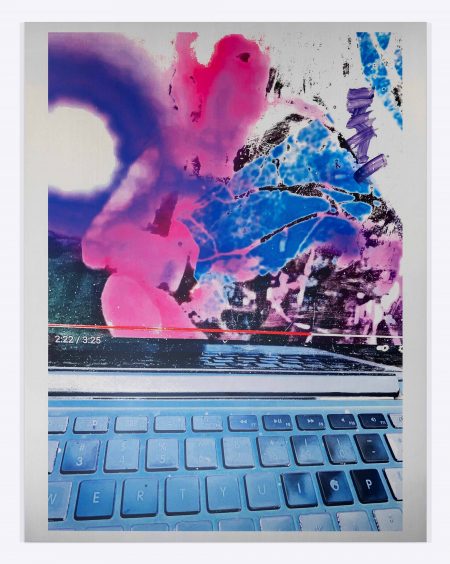
2:22
2021
Dye sublimation print and acrylic on aluminum
62 x 47 7/8 inches (157.5 x 121.6 cm)
In this series of “paintings” Harrison wields the Scanner Pro cellphone app and “turns it on three dimensional spaces that elude the program’s settings. Confusion results, and the app spits out the visual data it can’t process in splashes of unnatural color.” The language of “confusion” from the press release is apt for more reasons than one, as the pieces themselves inspire confusion. These pieces are printed on aluminum sheets rather than canvasses. They transmit vivid, glowing colors that generate alternate visions of a world becoming something futuristic or perhaps – re: Predator – something alien. They halt the ability of human vision to recognize what should be familiar objects and spaces while also inviting us to reconfigure our ability to invoke recognition as a function of vision and hence, rendering the ordinary into the otherworldly. These pieces force us to imagine the world with a different point of view. Harrison asks us to put on the cybernetic mask and reflect on how that mask has revised our perspectives of our environments and ourselves.
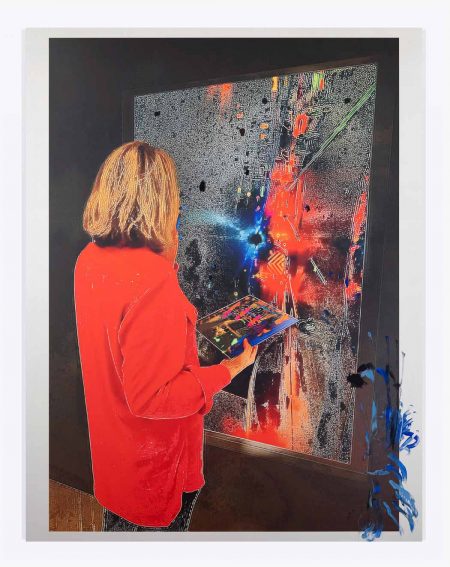
Studio
2021
Dye sublimation print and Flashe on aluminum
62 x 47 7/8 inches (157.5 x 121.6 cm)
One image quite literally turns the camera on the artist. In a studio, she stands at an easel painting – perhaps one of these images. Her red jacket and yellow hair burn off the aluminum surface while her painting explodes like lava from a volcano. Another image takes the Scanner Pro into a forest, producing an image that looks almost exactly like a snippet from Predator. The forest glows with bright greens while the profiles of dark trees center the image. In both images, the interior and exterior spaces are rendered into futuristic visions. They are at once familiar and strange, both old and new. You’ve seen these spaces before, but you’ve never seen these spaces before. Importantly, both paintings are only layered with small, single colored paint splatters towards the bottom left edges.
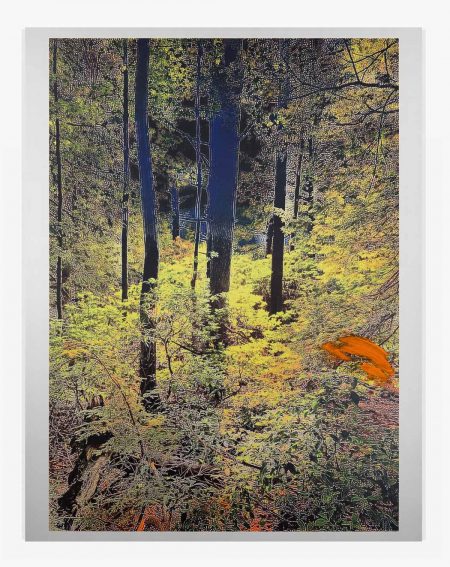
Trees
Dye sublimation print and Flashe on aluminum
62 x 47 7/8 inches (157.5 x 121.6 cm)
In an earlier paragraph I put parentheses around “paintings,” because the series is advertised as a collection of paintings, yet they do not fit that simple mold. The pieces, while remediating human vision, also work to remediate what precisely we mean by “painting.” The success of the series relies on the foundations of the Scanner Pro generated image. The printed surface is then slightly marked by the residues of good old-fashioned paint. You might, as I did, look at the works in this exhibition and ask, “is this a painting?” In a traditional sense, they certainly are not. Harrison, of course, is not concerned with anything traditional here. So, should we call them paintings by virtue of a bit of paint being smeared over a piece of digital art? Herein the work might draw confusion from viewers. She might also be coaxing these exact questions from us. Rather than opting for a traditionally photographic or filmic medium to create, here she opts to meld forms, resisting any one method of creation. Harrison engages intimately with questions about the strictures of artistic form to question how we see and experience art—or anything at all—by way of digital remediation.
True to formal resistance, her paintings are then complemented by a collection of sculptures strewn across the rooms of the gallery, allowing the collection to work together to generate this alternate worldly space. The sculptures are inflected with color pigments that remain consistent with the vivid images on the walls, occasionally accompanied by small everyday objects. One larger piece, towards the middle of the space, compiles a few large slabs with a glass box on top. The box contains a statue of Venus splashed in color. The whole of the piece invokes a sense of the unreal, and yet at the very bottom, two tennis shoes squashed between the base of the sculpture and the floor. The slabs, which we might imagine being found in a construction yard before being painted, look like urban debris. Human objects like the shoes meld with this debris, indicating the haunting presence of some lost humanity.
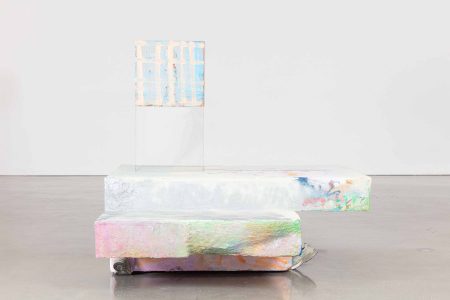
Venus
2021
Wood, polystyrene, plexiglass, acrylic, enamel, Venus statue, and pair of New Balance 990 shoes
63 ½ x 69 x 69 inches (161.3 x 175.3 x 175.3 cm)
The exhibition culminates in a final room with a lone work that fills the room. Threads of yard splice back and forth across the room, sheets of neon and white paper hanging along them. Another sculpture sits in the middle while a chair floats in midair and a six pack of Coors Light awaits an eager drinker. Colorful lights oscillate as if to designate this as a celebratory space. The space forces one to engage in way that might feel unfamiliar, or even uncomfortable to a gallery goer. As one dodges string and paper to get a closer look at each sheet one might be reminded of the complicated human entanglements that must be navigated in both real and technological settings; these threads are not ones that we can simply stand and gaze at, rather, they require a bit of weaving to get a closer look. This space, however, is perhaps the most direct political portion of the show. Before you let the bright colors of the collection convince you that Harrison compiles a vision of a cybernetic utopia, you begin to see reference to 2021’s January 6th uprising along the collection of hanging paper – or if you read the title of the piece first, you know that the objects were present at the insurrection. Many of the papers are clippings from news sources and social media, reflecting on how most of us experienced that event through mediated technological modes. This space is, in fact, not a party space.

Hot Topic #2
2022
Cast iron hooks, pigmented inkjet prints, parachute cord, wood, LED party light disco
balls, and things brought to the insurrection
11 ft x 17 ft 6 inches x 28 ft 5 inches (335.3 x 533.4 x 866.1 cm)
To allow the exhibition to be contextualized by this room might share properties with a contextualization of the exhibition by the McTiernan film. A shrewd reading of Predator might observe that the men led by Schwarzenegger are themselves shrewd. When Jesse Ventura makes a flippant homophobic remark toward the men who refuse to chew tobacco, we might question who the “predator” of the film is. The forest is just as unwelcoming to the men as it is to the alien. Perhaps then, the so called “predator” is, in fact, on the defensive – the real heart of the film, then, seeks to reveal the predatory behavior of the human. Perhaps, as that final room alludes, Harrison’s collection is an engagement of human and extra-human predators. Perhaps she’s confronting the predation of corporations and white supremacists as well as the cybernetic folds of the cloud, the internet and all the mysterious places that absorb our data.
Rather than a cybernetic utopia, the work then becomes a meditation on the enfolding powers of the increasing influence of technological apparatuses. As we gaze on the sideways image of the city building through the lens of the Scanner Pro pigments, we begin to wonder if we’re seeing everything through the viewpoint of the technological. Art falls into a long line of worldly realities that are being remediated increasingly through the eyes of digital ethers. You might think of a recent advertisement for Mark Zuckerberg’s Metaverse which animates and attempts to absorb viewers into a popular painting in New York’s Museum of Modern Art. The silver lining of Harrison’s work is that she is aware that the experience of being sucked into Zuckerberg’s Metaverse version of that painting is nothing like the experience of gazing on that painting from a foot away.
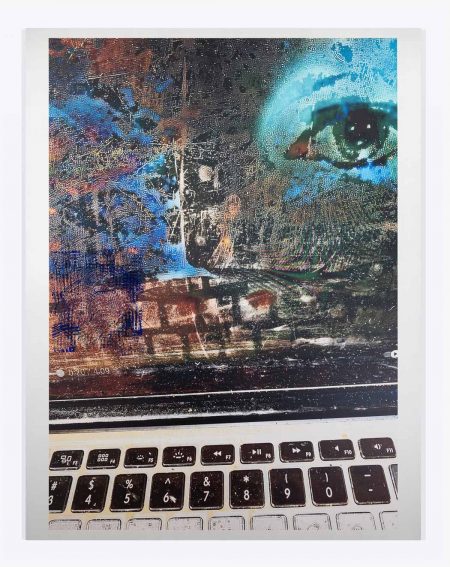
YouTube
2021
Dye sublimation print and Flashe on aluminum
62 x 47 7/8 inches (157.5 x 121.6 cm)
Crucially, aside from the final room, the Harrison avoids explicit statements. The exhibition avoids establishing a cybernetic dystopia as much as it does utopia. It seeks to generate an unfamiliar version of a familiar reality. Reminders of political unrest, as in real life, don’t disappear when one enters in a club with strobe lights. When we leave that room and reflect on the so called “paintings” one more time, we should drop our lingering suspicion that these are something other than “paintings.” Rather, paint functions to remind us that despite the encompassing powers of digital remediation, old forms are here to stay. Harrison’s sparse use of paint reminds us that the power of paint endures alongside the technological. Whether or not this is a good or a bad thing seems to fall by the wayside. There may be an increasingly sinister remediation of the world through technology happening before our eyes, but something as simple as the Scanner Pro app can help produce images that are often quite beautiful.
Caution Kneeling Bus is on view through February 20th, 2022
–Josh Beckelhimer